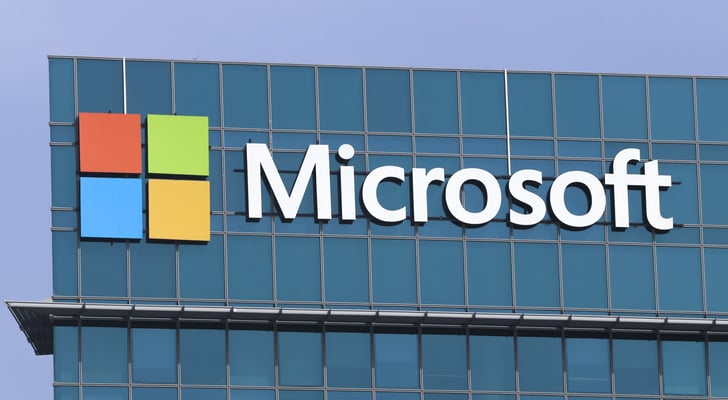
After a brief dip, Microsoft Corporation (NASDAQ:MSFT) has resumed its rally. Microsoft stock trades at another all-time high; MSFT stock now has nearly quadrupled since the beginning of 2013.
Microsoft stock did take a hit after its fourth-quarter earnings on January 31. MSFT dropped from $95 to $85 in just six sessions, despite beating consensus estimates on the top and bottom lines. But as I argued last month, Microsoft’s problem really was just timing.
The report itself was strong enough to get MSFT stock over $100 for the first time; the problem was that it was delivered into a rattled broad market. With that broad sell-off over, MSFT has rebounded, and sits just 3.3% shy of triple digits.
With the short-term chart looking stronger, the focus then turns to the long-term. What are the risks that can end the multi-year run in Microsoft stock? And there are risks; indeed, I was rather skeptical toward MSFT before coming around to the story last year. The good news is that, at least for the time being, the risks seem minimal, and worth taking. But there are some areas where long-term investors need to keep their eyes open, and their guards up.
Microsoft Corporation and Azure
One clear risk centers around the company’s cloud platform. Azure is a key part of the case for Microsoft stock in that it provides a growth driver not available elsewhere in the business.
And a big problem with Azure is that it still sits a distant second to the leader, Amazon.com, Inc. (NASDAQ:AMZN). Microsoft hasn’t disclosed Azure revenue yet, just growth rates, but in January KeyBanc estimated a $3.7 billion contribution in fiscal year 2017. Given growth of 90% in Q1 and 98% in Q2, according to Microsoft earnings releases, that business now likely is at a $5 billion-plus run rate. Amazon Web Services (AWS), meanwhile, posted $17.4 billion in revenue in 2017 — more than three times as much.
The good news, however, is that Microsoft is catching up. AWS revenue grew 43% last year, implying solid market share gains for Azure. Meanwhile, AWS may face some headwinds as it expands into other businesses. Businesses that compete with Amazon elsewhere already are moving away from AWS, among themKroger Co (NYSE:KR). That potentially opens up more dollars for Microsoft — if it can keep other competitors like Alphabet Inc (NASDAQ:GOOGL,NASDAQ:GOOG) and Oracle Corporation (NYSE:ORCL) at bay.
So far, that’s been the case. But with Azure likely accounting for only about 7% of FY18 revenue, and yet still driving some of the optimism toward future growth, any stumble here will be punished.
Could PCs Still Hit Microsoft Stock?
As impressive as recent overall results have looked, recent growth actually is a change for Microsoft. Between fiscal 2012 and fiscal 2016, adjusted earnings per share (EPS) barely moved. It’s tough to remember now, with MSFT stock trading at about 24x forward EPS, but the stock actually traded at 10-12x earnings for the first few years of this decade.
The market’s caution was understandable. Over half of Microsoft revenue came from the PC — and that business looked flat at best. Smartphones from Apple Inc. (NASDAQ:AAPL) and, at the beginning of the decade, BlackBerry Ltd (NYSE:BB) were eroding PC usage. Microsoft’s own efforts in the space were a flop, with the acquisition of the phone business from Nokia Oyj (ADR) (NYSE:NOK), one of the biggest M&A busts of all time.
But, surprisingly, Windows and Office revenue are growing nicely. The shift to cloud-based offerings from on-premise (ie disk-based) sales has not just shifted revenue. It’s grown it. Office consumer revenue has increased a solid 12% in the first half of FY18. Windows revenue is outpacing the roughly flat PC market.
The concern is for how much longer this can really last. PC sales have dropped for six consecutive years. So far, the declines have been reasonably modest — but a big step down could have a significant impact on Windows revenue, in particular. For Office, the question is whether Microsoft can continue to drive growth — or if it’s captured most of the customers most likely to move to cloud and add extra services in the process. Over 40% of revenue still comes from PC-related activities — and if growth there stalls out or even turns negative, it could be a big problem for MSFT stock.
Second-Place Problem for Microsoft Stock
I’ve long worried about Microsoft’s “second-place problem” outside of the PC business. But in those second-place categories, Microsoft is showing some growth. Dynamics is competing well against Salesforce.com, Inc. (NYSE:CRM). Even Bing is showing nice growth, up 15% year-over-year through the first half.
It’s not as if Microsoft needs to displace Salesforce.com, or Google. Simply being a solid competitor in markets with overall growth is enough to keep Microsoft’s top and bottom lines growing.
At current levels, that’s probably enough — although valuation remains a risk here as well. MSFT stock trades at a reasonable approximately 22x forward multiple, backing out its net cash. High-single-digit/low-double-digit EPS growth probably is enough to maintain that multiple. And what Microsoft is doing at the moment is enough to keep that growth going — and to push Microsoft stock above $100.
But it will have to keep this momentum going — and keep getting cooperation from the broad market. As the January/February sell-off shows, the earnings multiple assigned to MSFT stock does have room for compression, and a turn or two decrease there could offset earnings growth.
And if that growth slows, the narrative surrounding Microsoft stock could change. For now, however, everything looks good enough to keep the rally going.
As of this writing, Vince Martin has no positions in any securities mentioned.
https://investorplace.com/2018/03/risks-could-derail-rally-microsoft-corporation-msft-stock/Bagikan Berita Ini














0 Response to "These Risks Could Derail Rally in Microsoft Corporation"
Post a Comment